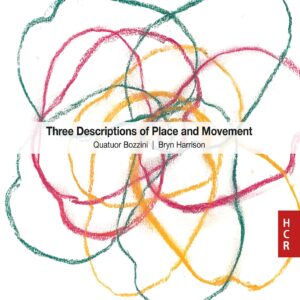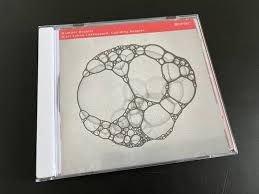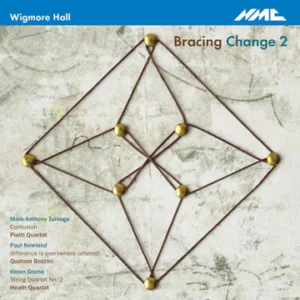
Bryn Harrison
Three Descriptions of Place and Movement
Quatuor Bozzini
Huddersfield Contemporary Records, 2022
Composer Bryn Harrison writes about temporal organization and experience in music. Coauthored with Richard Glover and Jennie Gottschalk in a collaborative spirit, Being Time (Bloomsbury, 2018) examines the experiences of the three authors listening to music built in different time spans, from the longest works of Morton Feldman to micro music. Harrison explores these concerns in his own music, particularly subtle variations over significant durations. Three Descriptions of Place and Movement, his first string quartet, written for Quatuor Bozzini and recorded for Huddersfield, is both intricately organized and imposing in structure. At over an hour long, it is an opportunity to see Harrison’s vision writ large.
Feldman is an obvious touchstone for pervasively slow music over a long duration, and Harrison’s work certainly has echoes of Feldman, but Three Descriptions of Place and Movement also departs from Feldman’s aesthetic in both its surface and structuring. The music is populated by changes in bowing techniques, mini-crescendos and just as quick returns to piano, and a plethora of articulations. It challenges the listener’s attention to detail by constantly shifting between these various techniques. What starts as a principal texture may shift to accompaniment, counterpoint, or a mixture of roles. Harrison says that he uses shapes like a wrapped double helix in “Opening,” to organize material so that one constantly hears it from different vantage points.
Each successive movement is longer, which plays with perception as well. The movement titles – “Opening,” “Clearing,” and “Burrow” are each meant in two senses: the place and movement of the title. Thus, a musical opening may introduce material that brings one into the piece’s orbit; an opening also can be of a door, or a mind. Harrison suggests similar dualities for “Clearing” and “Burrow.” When each movement’s central process has been worked out, it ends with surprising suddenness.
The Bozzini Quartet are a perfect ensemble for the challenges of Harrison’s score, its demanding specificity of expression, dynamics, and rhythm. Cascading entrances and myriad bowing techniques and articulations are delivered crisply, with abundant clarity. The work’s sinuous chromaticism is rendered with admirably spot-on tuning.
Three Descriptions of Place and Movement is Harrison’s most successful and distinctive work to date. Once again, Huddersfield Contemporary Records presents a risk taking artist in the best possible sound and performance conditions. Recommended.


